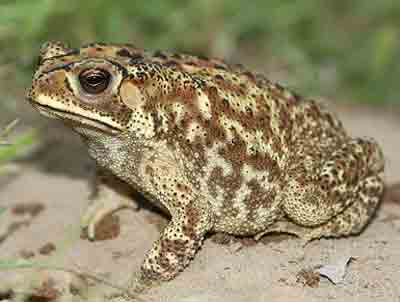Common Asian Toad Skeleton Duttaphrynus melanostictus cm 10.2 Amphibia Anura Bufonidae, only a piece, as in photos.
Family: Bufonidae.
Common name: Asian Common Toad, Asian Black-Spined Toad, Asian Toad, Black-Spectacled Toad, Common Sunda Toad, Javanese Toad.
Syn. Bufo melanosticus.
Duttaphrynus melanostictus is probably a complex of several species of toad widely distributed in Southeast Asia.
The species grows up to about 20 cm in length. They reproduce during the monsoon season and their tadpoles are black. Young toads can be seen in large numbers after the end of the monsoon rains.
The upper part of the head has different bony ridges, the muzzle is short and blunt. The first finger is often longer than the second and the toes are at least half webbed.

Common Asian toads reproduce in still or slow-moving rivers and temporary or permanent ponds. Adults are terrestrial and can be found under ground cover such as rocks, bedding and trunks, but they are also associated with human houses, often spotted at night under street lamps, especially when the winged termites swarm. They feed on a wide range of invertebrates, including scorpions.
They have been recorded from sea level up to 1,800 m above sea level and live mostly in lowland habitats, from beaches and river banks to agricultural and urban areas dominated by man. They are rare in closed forests.
D. melanostictus arrived in Madagascar in 2011: these alien toads can have a significant impact on native Malagasy animal life and contribute to the worsening biodiversity crisis in the region.
D. melanostictus was introduced to the Indonesian island of Bali in 1958, Sulawesi in 1974, then subsequently to Ambon, Lombok, Sumba, Sumbawa, Timor and New Guinea, etc. where it has now become common. The Asian common toad has also been detected in Australia at least four times since 2000. The most recent incursion, in 2015, was in the suburbs of Sydney. The Asian common toad has therefore been described as one of the "10 most undesirable species" in Australia and "potentially more harmful than the cane toad". It can cause serious ecological problems due to "competition with native species, its potential for spreading exotic pests and pathogens as well as its toxicity". Like the cane toads, the Asian common toad secretes toxins from the glands of their back to discourage predators. These toxins, beyond a reasonable doubt, seriously affect native predators, such as snakes, goannas and quolls.
The recent incursion rate suggests a high probability of settlement in Australia. Thus, experts ask the Australian government to develop a "high priority emergency plan" that includes stronger environmental quarantine and surveillance strategies.



